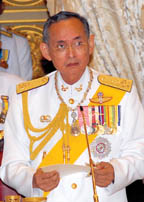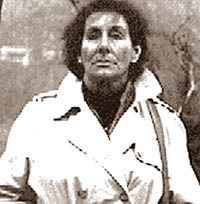
King Bhumibol: The longest reigning monarch
In early June, Thailand celebrated King Bhumibol Adulyadej's 60th
year on the throne. He was not born to be king. It was the untimely and
tragic death of his elder brother King Ananda Mahidol, on June 9, 1946,
that put Bhumibol Adulyadej on the throne. He was only 18 years at that
time.

King Bhumibol Adulyadej was born on December 5, 1927 in America. He
was the third child and second son of Prince Mahidol, and was named
Bhumibol Adulyadej, which means "strength of the land."
In 1932, there was a coup (pronounced coo) in Thailand. A coup is a
sudden, illegal and often violent change of government. Because of the
unsettled conditions in Thailand, the family lived in Switzerland from
1933. So the two princes had their education in Lausanne, Switzerland.
Prince Bhumibol entered Lausanne University and studied science.
In 1948, Bhumibol Adulyadej, two years king, but still uncrowned, met
with a serious motor car accident. One eye was damaged. The muscles of
one side of the face have been stiff since the accident, giving the king
a stern expression. The muscles don't move when he smiles. Early in
1950, he became engaged to Mom Rajawongse Sirikit, the beautiful
daughter of the Thai Ambassador in Paris.
After the royal family's return to Thailand, they married on April
25, 1950. A week later was the coronation. This happened on May 5,
1950.As canon shots were fired and bells rung, announcing the
coronation, the King made this vow:
"We will reign with righteousness for the benefit and happiness of
the people of Siam." Royalty always speaks of themselves in the plural.
The king used the old name for the country. Thailand became the official
name for Siam only in 1940.
For 60 years, king Bhumibol Adulyadej has kept his promise, working,
without any show, for the benefit and happiness of his people.
From 1782, the kings of Thailand belonged to the House of Chakri.
(The present Royal family of England belongs to the House of Windsor).
The first king of the Chakri dynasty was Rama, and all the kings after
him took the name Rama - Rama II, Rama III etc. The present king is
Bhumibol Adulyadej Rama IX.
The most famous king of this dynasty, Chulalangkorn Rama v, reigned
for 41 years, from 1868-1910. Rama IX has been king 20 years more than
his famous great grandfather. When Bhumibol Adulyadej became king in
1946, Thailand was already a constitutional monarchy.
Until 1933, it was an absolute monarchy where the king had all the
powers of a ruler. Now the king is Head of State. He has authority, but
the Prime Minister and his ministers rule the country.
King Bhumibol Adulyadej changed the role of the monarchy. "Serve the
People" was his motto. This, he believed, was the real work of a royal
family. The king has palaces in the major regions, where he spends
weeks, making the palace his base to visit the villages. One or more of
their children always accompany the king and queen. In this way, their
only son and three daughters have bonded with the rural folk.
The king has initiated projects for the proper management of forests,
built reservoirs and irrigation channels, and constructed roads to
enable villagers to bring their produce to market towns. There are
pictures of him working in rice-fields and wading in channels.
All this has endeared him to the people, His picture hangs in homes
and taxis, pasted on ploughs, worn round necks and tucked into wallets.
King Bhumibol's 60 year reign has not been a bed of roses.
He has had to face insurgencies (uprisings) and coups, deal with
military dictators and corrupt politicians. In all these crises, this
jazz-loving king has kept his cool. The people regard him as their
constance refuge. Thais compare him to "the comforting shade of a large
tree."
Sumana Saparamadu
Anne Ranasinghe: Internationally renowned poet
Have you ever heard about the internationally renowned poet Anne
Ranasinghe? Did you know that this brilliant poet escaped from Nazi
Germany to England, married a Sri Lankan, and became a citizen of Sri
Lanka?

She was born on October 2, 1925 as Anneliese Katz in Essen, Germany.
In 1939, this 13-year-old Jewish girl arrived in England; her parents
had managed to send her there to stay with relations, to escape the Nazi
regime, but they themselves could not emigrate, and were murdered in
Chelmno, Poland, five years later. Anneliese went to school, then
trained to be a nurse.
Later, she met, and married, a Sri Lankan Postgraduate and settled
down with him in Sri Lanka. In 1956, she became a Sri Lankan citizen.
Her husband was appointed Professor and Head of the Department of the
Medical Faculty of Colombo, and she devoted the first years in her new
home country to her young family - their four children and three from
her husband's first marriage.
In the sixties, she began to study journalism, and in 1971, she made
her debut with a slim volume of poems titled And the Sun That Sucks The
Earth to Dry. Although primarily a poet, she has also published short
stories, essays, and translations. Her works have been broadcast on
radio and published in 17 countries and translated into nine languages.
Drawing from her own life's experiences, her writing has been
described as "vibrantly sensuous or stark and deeply moving."
In Sri Lanka, she is considered one of the foremost poets writing in
English. She has been translated into Sinhala, Tamil, Dutch, German,
Hebrew, Serbo-Croat as well as French and Swedish.
Anne Ranasinghe has won numerous local and international awards for
her writing, including the Sri Lanka Arts Council Prize for Poetry in
1985 and 1992, and for non-fiction in 1987. In 1994, she won the Sri
Lanka Literary Award for the best collection of short stories.
She is a founder member of the English Writers' Cooperative of Sri
Lanka and regular editor of its journal, Channels.
Her name has been included in The Oxford Companion to Twentieth
Century Poetry. |


